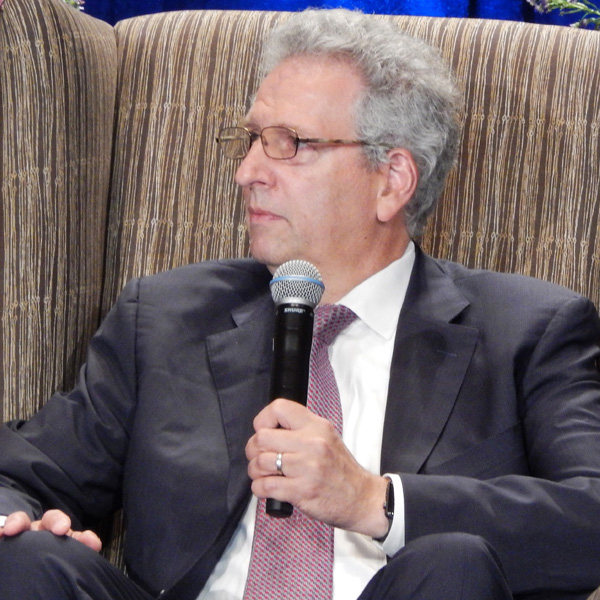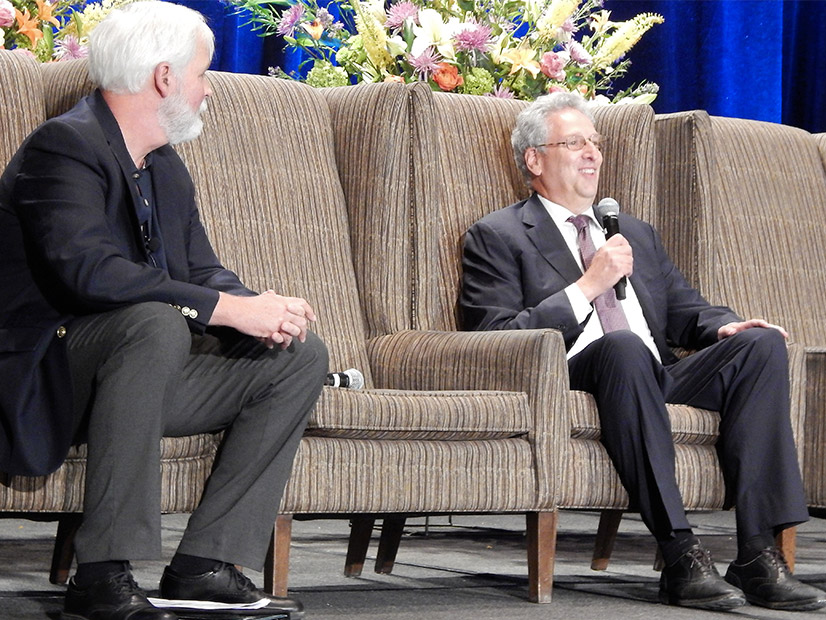DENVER — FERC Chair Richard Glick brought a desire to improve communications with state regulators and a personal soundtrack to the National Association of Regulatory Utility Commissioners’ Summer Policy Summit on Wednesday.
Taking the stage to the strains of Elvis Costello’s “(What’s So Funny ’Bout) Peace Love and Understanding” — “That’s a song I really like,” he said, explaining his choice — Glick sat down with NARUC President Paul Kjellander for a wide-ranging discussion on the organizations’ joint transmission task force and the challenges facing regulators and the industry.
Kjellander commended Glick for reaching out to NARUC within 24 hours of assuming FERC’s chairmanship earlier this year and setting up phone calls with the other four commissioners. “We’ve been able to have meaningful conversations from the very beginning,” he said.
Glick credited former FERC Commissioner Cheryl LaFleur for stressing the importance of having a strong relationship with NARUC. He said he knew transmission was the perfect issue to find solidarity with the states.
“From my perspective, we can learn more from the states,” Glick said. “Cost allocation, planning, siting … that’s one area we needed to work together, because those are difficult issues. We can’t achieve our goals, the states can’t achieve their goals, if we don’t work together. We’ve laid out a vision, and it’s worked out very well.”

Glick said he has been encouraged by his conversations and overall positive feedback he has been receiving from state regulators. He said he hopes that “solid input” continues with the recently announced joint federal-state task force on electric transmission.
The task force, comprising all five FERC commissioners and 10 state regulators, is intended to spur increased transmission development to deliver renewable power, reduce congestion and improve reliability (AD21-15). (See FERC Sets Federal-State Taskforce to Spur New Tx.) Glick hopes the team can hold its first meeting in November during NARUC’s annual meeting in Louisville, Ky.
“There’s a lot of people at FERC looking forward to working on it,” he said, promising a positive agenda for the meeting.
NARUC has selected 10 nominees to represent the states, divided equally among the organization’s five regions. The nominees were selected from 38 candidates, any of whom would have been equally qualified to serve, Kjellander said.
“I could have put all 38 names on a wall, thrown a dart and hit the perfect candidate,” Kjellander said. “Can I have five more?”
“We could talk about that,” Glick said. He said he would have to talk with the other commissioners, but he promised state regulators other opportunities to stay engaged through the commenting process.
“How can we help you while getting everything we want?” Kjellander jokingly asked Glick. “You can’t throw rocks through the window and expect to be invited for dinner.”
“We have some protesters that throw rocks through our window,” Glick quipped in response, before turning serious.
“Our commissioners are wildly supportive of the [task force],” he said. “There has been some tension between states and FERC. This is a way to work together on some of the issues.”
Glick reminded his audience that they have the ability to go outside Order 1000’s directive on competitive projects. FERC last week opened a rulemaking to reconsider its rules on transmission planning, cost allocation and generator interconnections. (See FERC Goes Back to the Drawing Board on Tx Planning, Cost Allocation.)
“States can do that on their own. They can work with other states; they can work with utilities,” he said. “It’s just a reminder that there are other ways to do this. I hope the states can work together in a voluntary way that doesn’t necessarily involve FERC’s cost allocation and planning processes.”
On Monday, NARUC filed its nominees for the task force. They include:
- Pennsylvania Public Utility Commission Chair Gladys Brown Dutrieuille and Maryland Public Service Commission Chair Jason Stanek, representing the Mid-Atlantic Conference of Regulatory Utilities Commissioners;
- Kansas Corporation Commission Chair Andrew French and Michigan Public Service Commission Chair Dan Scripps, representing the Mid-America Regulatory Conference;
- Vermont Public Utility Commissioner Riley Allen and Massachusetts Department of Public Utilities Chair Matthew Nelson, representing the New England Conference of Public Utilities Commissioners;
- North Carolina Utilities Commissioner Kimberly Duffley and Arkansas Public Service Commission Chair Ted Thomas, representing the Southeastern Association of Regulatory Utility Commissioners; and
- Idaho Public Utilities Commissioner Kristine Raper and California Public Utilities Commissioner Clifford Rechtschaffen, representing the Western Conference of Public Service Commissioners.
“We look forward to the next steps in the process and creating the much needed federal-state coordination to better serve the public interest,” Kjellander, who chairs the Idaho PUC, said in a statement.
FERC must next officially appoint the state participants from NARUC’s nominees. Those appointed will serve one‑year terms that can be renewed for a total of three years. Their responsibilities will include conducting outreach to other commissioners and commissions in their regions “to ensure the task force receives a broad view of the regional issues.”
FERC, NARUC and state public utility commission staff will support the task force.
“We’re not going to have public statements and go home,” Glick said. “I hope we have a dialogue between meetings. It’s going to take quite a bit of time to sort this out.”


